ASRock Industrial NUC BOX-1260P and 4X4 BOX-5800U Review: Alder Lake-P and Cezanne UCFF Faceoff
by Ganesh T S on August 5, 2022 8:15 AM EST- Posted in
- Systems
- AMD
- Intel
- UCFF
- Mini-PC
- ASRock Industrial
- Cezanne
- Alder Lake-P
HTPC Credentials
The HTPC-related sections in previous SFF PC reviews covered a range of aspects. Display refresh rate stability (particularly, the ability to drive 23.976 Hz for stutter-free playback of cinema content), OTT streaming efficiency (YouTube and Netflix), and local media playback performance and efficiency evaluation were some of them. While such a detailed study may still make sense for dedicated HTPC reviews, we have decided to pare down the evaluated aspects for system reviews. Workloads were processed on the NUC BOX-1260P and the 4X4 BOX-5800U (Normal Mode) for the results in this section.
YouTube Streaming Efficiency
4K video streaming has become ubiquitous enough for its support to be a necessity even for secondary HTPCs. HDR has also become affordable. Both systems under consideration today can display HDR content in HDR. Keeping these aspects in mind, we have chosen Mystery Box's Peru 8K HDR 60FPS video as our test sample moving forward. On PCs running Windows, it is recommended that HDR streaming videos be viewed using the Microsoft Edge browser after putting the desktop in HDR mode.

YouTube Streaming Statistics
ASRock Industrial 4X4 BOX-5800U (L) and ASRock Industrial NUC BOX-1260P (R)
The integrated GPUs in both systems support hardware decoding for VP9 Profile 2. Taking advantage of this feature, MS Edge automatically fetches the 4Kp60 VP9 Profile 2 encode from the YouTube servers. However, the playback quality was markedly different - while the Alder Lake system played back the clip almost perfectly (the few dropped frames were during resolution changes / triggering of overlays), the Cezanne system had evident stuttering as a result of almost 10% of the frames getting dropped.
The decoding efficiency (GPU usage and at-wall power consumption against time) for the YouTube playback session is graphed below for both systems.
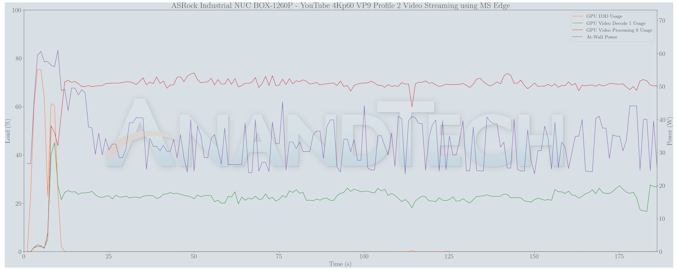
YouTube Streaming Decoding Efficiency - ASRock Industrial NUC BOX-1260P
 YouTube Streaming Decoding Efficiency - ASRock Industrial 4X4 BOX-5800U
YouTube Streaming Decoding Efficiency - ASRock Industrial 4X4 BOX-5800U
The reason for the dropped frames seems to be in the excessive D3D usage of the Cezanne GPU. The decoder load is also quite high at 80% and the at-wall numbers are close to 50W. In contrast, the NUC BOX-1260P consumes around 32W for the same playback while dropping barely any frames. The load on the decoder is around 25% with the video processor logic in the GPU kept active around 70%. Overall, the hardware acceleration offered by Alder Lake-P is very effective, while the Radeon iGPU struggles here despite claiming hardware decoding support for VP9 Profile 2.
Hardware-Accelerated Encoding and Decoding
The transcoding benchmarks in the systems performance section presented results from evaluating the QuickSync encoder within Handbrake's framework. The iGPU in the NUC BOX-1260P support hardware encode for AVC, JPEG, HEVC (8b and 10b, 4:2:0 and 4:4:4), and VP9 (8b and 10b, 4:2:0 and 4:4:4). The capabilities of the decoder engine are brought out by DXVAChecker.
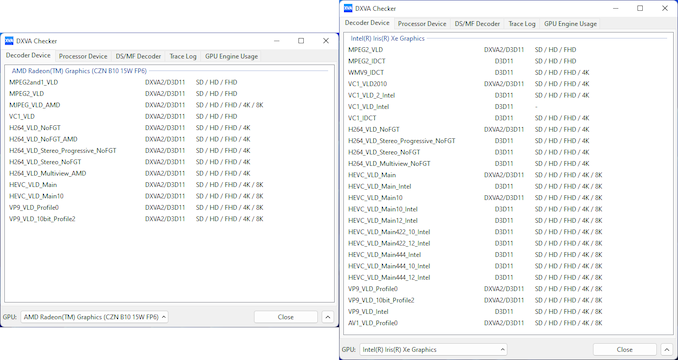
Video Decoding Hardware Acceleration
ASRock Industrial 4X4 BOX-5800U (L) and ASRock Industrial NUC BOX-1260P (R)
While MJPEG decode acceleration is available in Cezanne, Alder Lake-P does not offer it. In any case, most MJPEG streams are low-resolution and low-frame rate, which can be easily handled via software. The decoding capabilities of the Iris Xe Graphics are more comprehensive than Cezanne's.
Local Media Playback
Evaluation of local media playback and video processing is done by playing back files encompassing a range of relevant codecs, containers, resolutions, and frame rates. A note of the efficiency is also made by tracking GPU usage and power consumption of the system at the wall. Users have their own preference for the playback software / decoder / renderer, and our aim is to have numbers representative of commonly encountered scenarios. Considering the target market for UCFF systems like the ASRock Industrial NUC BOX and 4X4 BOX series, we played back the test streams using the following install-and-forget combinations:
- VLC 3.0.17.4
- Kodi 19.4
The fourteen test streams (each of 90s duration) were played back from the local disk with an interval of 30 seconds in-between. Various metrics including GPU usage and at-wall power consumption were recorded during the course of this playback.
All our playback tests were done with the desktop HDR setting turned on. It is possible for certain system configurations to automatically turn on/off the HDR capabilities prior to the playback of a HDR video, but, we didn't take advantage of that in our testing.
VLC and Kodi
VLC is the playback software of choice for the average PC user who doesn't need a ten-foot UI. Its install-and-play simplicity has made it extremely popular. Over the years, the software has gained the ability to take advantage of various hardware acceleration options. Kodi, on the other hand, has a ten-foot UI making it the perfect open-source software for dedicated HTPCs. Support for add-ons make it very extensible and capable of customization. We played back our test files using the default VLC and Kodi configurations, and recorded the following metrics.
| ASRock Industrial NUC BOX-1260P Video Playback Efficiency - VLC and Kodi | |||
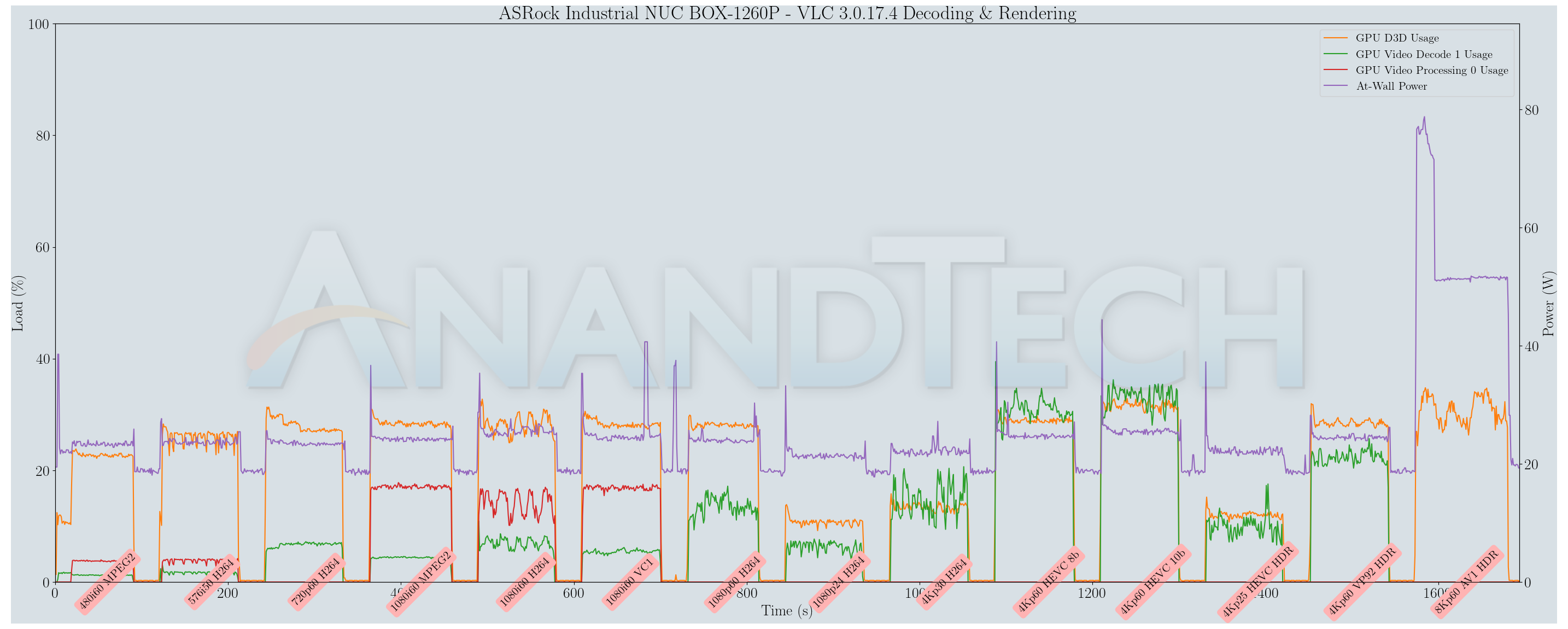
| ASRock Industrial 4X4 BOX-5800U Video Playback Efficiency - VLC and Kodi | |||
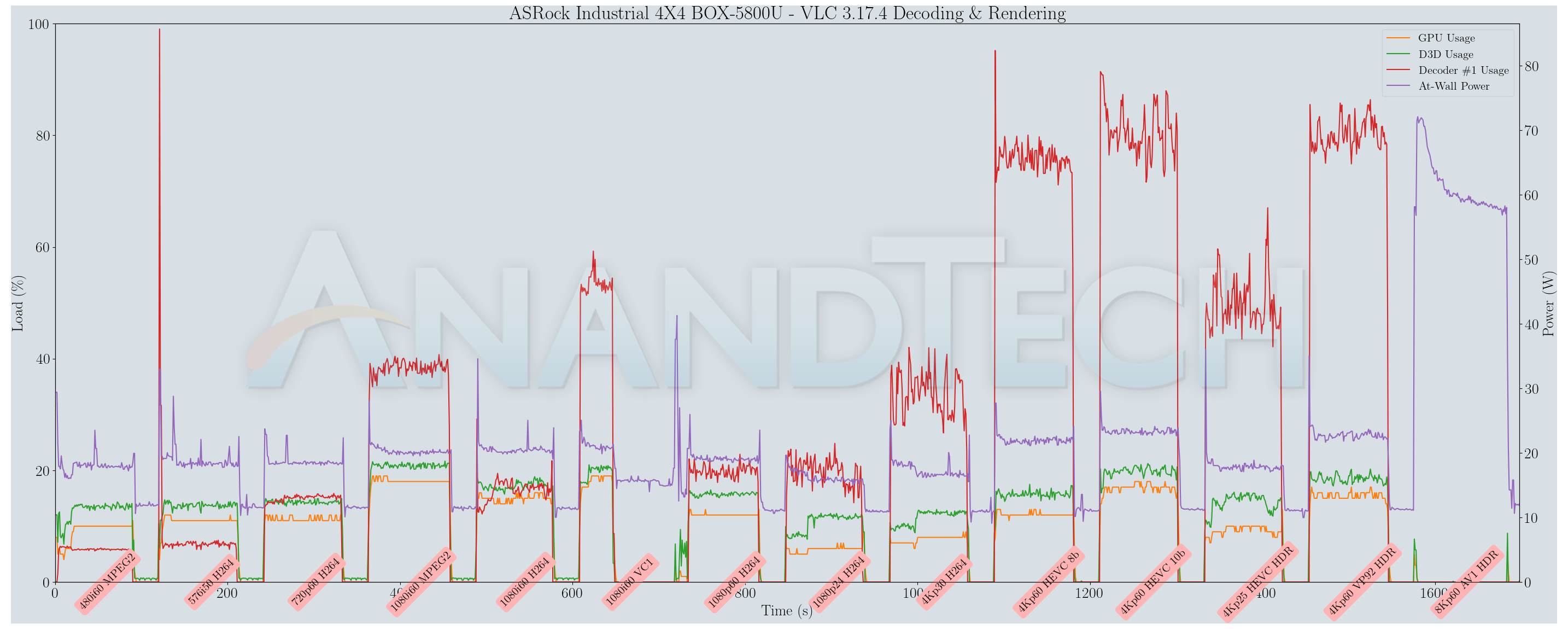
Both players in both systems had great trouble handling the 8Kp60 AV1 clip, due to the absence of hardware acceleration. In addition to consuming lots of power, the playback was just a sequence of frames updated every few seconds. Other than that, all other codecs played without missing a frame, with hardware acceleration activated for low-power playback in the NUC BOX-1260P. For the 4X4 BOX-5800U, some of the high frame-rate / high-resolution files encountered minor stuttering (seen when the decoder usage spiked upwards of 80% in the above graph) in VLC, but managed better playback in Kodi. The interlaced VC-1 clip presented some challenges, with the driver crashing mid-way through the playback in both VLC and Kodi. However, under certain Kodi configurations (in terms of full-sceren / windowed / window size), the playback would sometimes be successful. VLC would consistently crash.
While AMD needs to work on its drivers, the issue with the NUC BOX-1260P for AV1 decoding is one of software. Once Kodi and VLC get updates to take advantage of the hardware-accelerated AV1 decoding support in the newer Intel processors, the system should be able to play back the AV1 clip without issues.
Overall, the NUC BOX-1260P can be recommended for media playback of all varieties. The 4X4 BOX-5800U works well for most common codecs, but playback - either local or via network streaming - could sometimes be a hit or a miss depending on the codec, resolution, and browser.


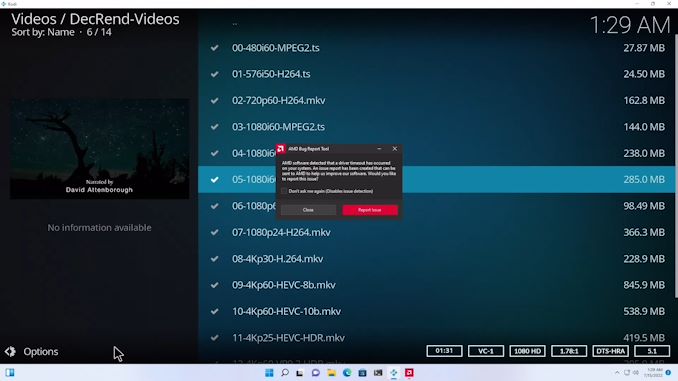








34 Comments
View All Comments
AdrianBc - Saturday, August 6, 2022 - link
Regarding the height of the case, there is no need to increase it. Intel has proved, already many years ago, that it is possible to cool without problems even a CPU with PL1 = 45 W, without increasing the volume over the classic high variant of NUC, i.e. with a volume under 0.7 L (as proven by the Skull Canyon NUC, which unfortunately did not have any successor, because Intel replaced it with much larger "NUC" computers intended for gaming).For better cooling in the same case, it would be enough to remove the possibility of installing a 2.5" HDD/SDD, while keeping the same size for the case.
The freed height could be used for a taller cooler, with enough capacity to cool even a 45 W CPU, not only a 28 W CPU.
AdrianBc - Saturday, August 6, 2022 - link
I want to add that even in the coolers of the same height the quality can vary a lot, presumably depending on price.I have a couple of the "8th generation" NUCs, and those had much better coolers than all the older NUCs that I have used, but also, from what I have heard or read, much better than the coolers of newer NUCs, which presumably have reverted to some cheaper coolers.
Those NUC8 coolers, not only are completely silent in normal use, but at maximum load on a Coffee Lake U i7 CPU with PL1 = 30 W and PL2 = 50 W, i.e. with a PL1 default value that is higher than the 28 W nominal value, there is absolutely no thermal throttling regardless how long the computer works at the maximum power consumption of 30 W and the junction temperature never exceeds 90 Celsius degrees.
So a more expensive cooler might also provide an improvement even when it is not taller.
plonk420 - Thursday, August 18, 2022 - link
3dprint one?AdrianBc - Saturday, August 6, 2022 - link
For some reason, the Thunderbolt connector has not been certified yet.Because of that, it cannot be advertised yet.
However, I have seen multiple reports that it works without problems, including in this article.
fishingbait15 - Friday, August 5, 2022 - link
So wish we could get these things running ChromeOS. I wonder if ChromeOS Flex would at least allow the Linux crosvm to run ...PeachNCream - Sunday, August 7, 2022 - link
Thinking that would be good also. What about Android x86 as an alternative? Both should still be well embedded in Alphabet's ecosystem and feature the end user monitoring, data collection, and commercialization recommendations that Google is so good at in terms of how it partners with advertisers to get you relevant, interesting ad content.You could also probably install Linux on bare metal if all you want is vanilla Linux though you aren't going to benefit from having your compute activities observed for better product placement that you would with Google distros of Linux.
iranterres - Friday, August 5, 2022 - link
Nice to see the core i6 in the benchmarks.MrCommunistGen - Friday, August 5, 2022 - link
I'd really love to see HDMI 2.1 ports on these machines since both AMD and Intel platforms should theoretically be able to support the newer standard from their iGPUs.If either supported HDMI 2.1 I'd consider using one as a multimedia box hooked up to a TV.
nandnandnand - Friday, August 5, 2022 - link
https://www.cnx-software.com/2022/01/05/intel-alde...https://www.theverge.com/2022/1/4/22855915/intel-1...
Intel only integrated HDMI 2.0b support. I guess another chip has to be added to get HDMI 2.1, like in this:
https://www.tweaktown.com/news/85259/gigabyte-brix...
Rembrandt supports HDMI 2.1, as will the iGPU in Raphael. Raptor Lake will add it according to this leaked slide:
https://www.notebookcheck.net/Intel-Raptor-Lake-S-...
So it will become more common to see HDMI 2.1 support in 2023-2024. DisplayPort 2.0 as well.
Igor_Kavinski - Saturday, August 6, 2022 - link
Excellent review, Ganesh! Really enjoyed seeing the battle between these two CPUs. Some of the wins for the Intel Alder Lake were surprising, like the iGPU and in some benchmarks like 7-zip, 5800U is a monster! Hope to see more "reviews done right" from you soon!